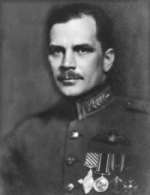George Croil
Air Marshal George Mitchell Croil CBE, AFC (June 5, 1893 – April 8, 1959) was a Royal Flying Corps pilot during World War I who went on to become the first Chief of the Air Staff of the Royal Canadian Air Force. He was asked to step down as CAS in 1940 and Croil then served as the Inspector-General of the RCAF[1] until his retirement in 1944[2] when the post of Inspector General was abolished.[3]
George Croil | |
|---|---|
 Croil in full dress uniform | |
| Born | June 5, 1893 Milwaukee, Wisconsin, United States of America |
| Died | April 8, 1959 (aged 65) Vancouver, British Columbia, Canada |
| Allegiance | |
| Service/ | |
| Years of service | 1914–1944 |
| Rank | Air Marshal |
| Battles/wars | World War I World War II |
| Awards | Commander of the Order of the British Empire Air Force Cross |
Early and family life
George Mitchell Croil was born on June 5, 1893 in Milwaukee, Wisconsin, United States of America. His parents, Thomas Croil and Christian Mitchell, were Scottish immigrants to the United States. George Mitchell Croil was a first cousin of US Brigadier General Billy Mitchell, a pioneer of American military aviation.[4]
When Croil was 11 years old, he moved, with his parents, to Montreal in Quebec where he attended the Westmount Academy from 1903 to 1907. From 1907 to 1911, Croil lived in Scotland, studying at Robert Gordon's College in Aberdeen. Remaining in Great Britain, Croil studied Civil Engineering for the next two years.[4]
In 1912 Croil moved to Ratnapura, Ceylon where he gained employment as an assistant superintendent with the Mahawale Tea and Rubber Estate. His duties included overseeing the work routines of 700 plantation workers and ensuring that the machinery was kept running.[4]
World War I
With the outbreak of World War I, Croil enlisted in the Gordon Highlanders as a private soldier.[5] He was soon commissioned, serving as a machine gun officer in the 5th Battalion of the Gordon Highlanders. In January 1915 he received an acting promotion to captain and took up duties as a company commander.[4]
In May 1916, Croil was detached to the Royal Flying Corps and undertook a two-month period of flying training. On successfully completing the course and receiving his pilot's wings in July 1916,[4] Croil was seconded from the Gordon Highlanders to the Royal Flying Corps with the temporary rank of captain.[6]
Inter-war service
Croil became a member of the Canadian Air Board in June 1920 and played a key role in the establishment of air bases at Morley and High River in Alberta.[4] On the establishment of the Royal Canadian Air Force in 1924, Croil was one its founder officers. Although the RCAF was described as an air force and had a separate rank structure in line with the British air force, the RCAF was under the authority of the Canadian Army. The following year, in 1925, Croil was posted to Great Britain where he served as a liaison officer with the Royal Air Force. Croil also took a course of training at the RAF Staff College, Andover.[2]
Returning to Canada by 1928, Croil was appointed Station Commander of RCAF Station Borden in Ontario which at that time was one of a very few RCAF training bases. Returning to Great Britain for further advanced training, Croil attended the Imperial Defence College. Crossing back across the Atlantic once more, in 1934 Croil was appointed Senior Air Officer with the RCAF making him the head of the RCAF. In 1938, Croil succeeded in obtaining the RCAF's independence from the Army and accordingly his post was upgraded to Chief of the Air Staff. Croil then only reported to the Minister of National Defence.[4]
World War II
Croil remained as Chief of the Air Staff until 1940 when he was replaced. He then served as Inspector-General of the Royal Canadian Air Force until 1944.
Croil died on April 8, 1959, in Vancouver, British Columbia.[2]
References
- Flight Global
- Juno Beach
- Godfrey of the RCAF
- RCAF Archived 2012-01-18 at the Wayback Machine
- Flight Global
- London Gazette
External links
- Juno Beach Centre – Air Vice-Marshal G.M. Croil
- Air Force Association of Canada – Air Marshal George Mitchell Croil, CBE, AFC, MiD and Cde (Fr)
- Canadian Air Force – Half a Century of Croil Hall
| Military offices | ||
|---|---|---|
| Preceded by Unknown |
Station Commander of Camp Borden 1928–1932 |
Succeeded by Unknown |
| Preceded by G O Johnson |
Senior Air Officer 1934–1938 |
Title discontinued Service head upgraded to Chief of the Air Staff |
| New title RCAF became an independent service |
Chief of the Air Staff 1938–1940 |
Succeeded by L S Breadner |
| Preceded by Unknown |
Inspector-General of the Royal Canadian Air Force 1940–1944 |
Post abolished |